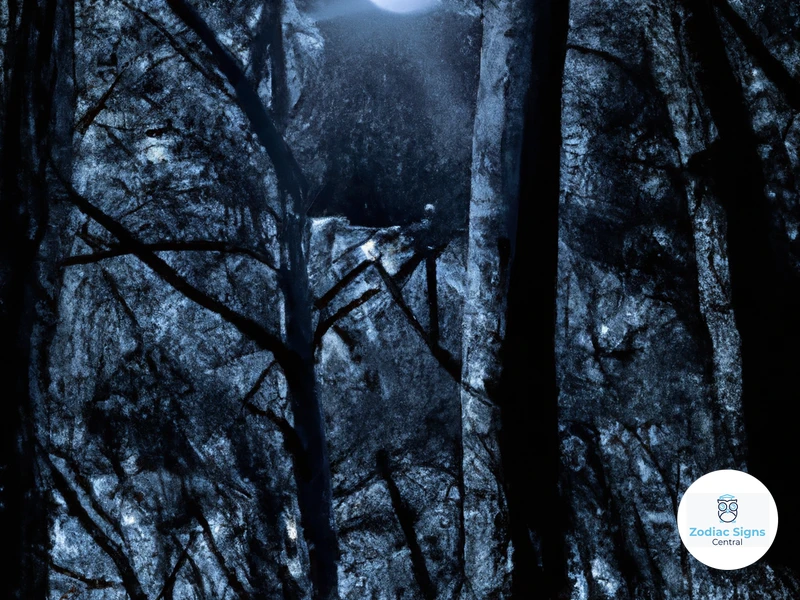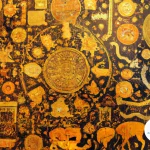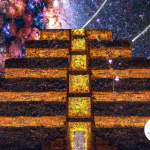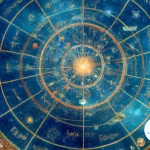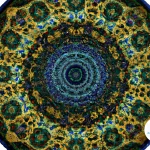The Moon, with its mystical allure, has captivated humanity for centuries. Its enigmatic beauty and gentle glow have sparked the imagination of poets, artists, and dreamers alike. But beyond its celestial charm, lies a rich mythology and symbolism that has transcended cultures and time. In this article, we will dive into the captivating world of the Moon, exploring the fascinating stories of lunar deities, the moon’s significance in ancient cultures, the symbolism of the Moon in astrology, and its role in horoscopes. Join us on this journey as we unveil the secrets and mysteries of the Moon’s mythology and symbolism.
The Lunar Deities
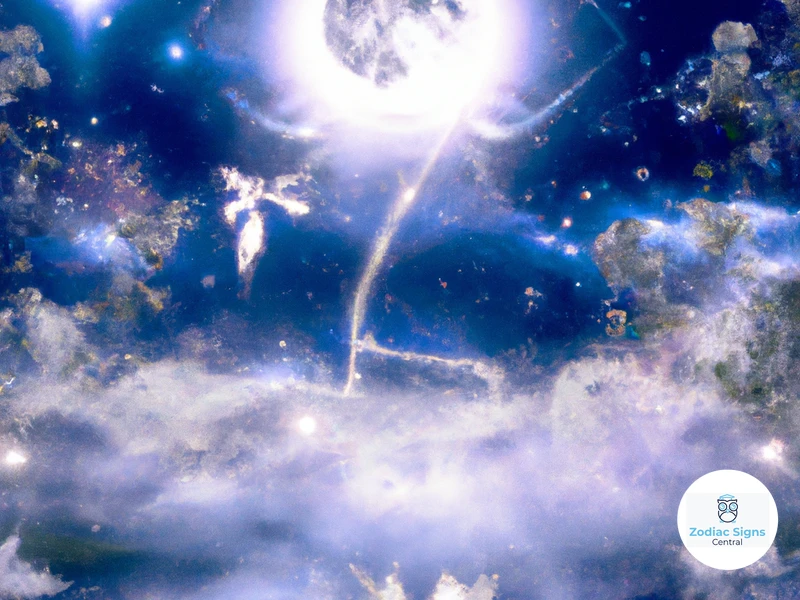
The Moon is closely associated with various lunar deities across different cultures. Let’s explore three prominent moon goddesses from different civilizations, each representing the moon in their own unique way.
1. Selene – The Greek Moon Goddess: In Greek mythology, Selene was revered as the goddess of the moon. She was often depicted as a beautiful woman riding a silver chariot pulled by two snow-white horses. Selene symbolized the lunar cycle and was believed to drive the moon across the night sky. Her gentle and unearthly glow cast a sense of calmness and serenity upon the Earth.
2. Luna – The Roman Moon Goddess: Luna, the Roman goddess of the moon, was closely associated with nocturnal activities and illumination. She personified the moon’s transformative power and was considered the protector of night travelers. Luna’s luminosity guided sailors and night wanderers, offering them light and protection during their journeys.
3. Chang’e – The Chinese Moon Goddess: In Chinese mythology, Chang’e is a prominent figure associated with the moon. According to legends, she ascended to the heavens after consuming the Elixir of Immortality. As the moon goddess, Chang’e is celebrated during the annual Mid-Autumn Festival. She is accompanied by the Jade Rabbit, who is believed to be her loyal companion on the moon.
These lunar deities highlight the significance and reverence given to the moon in different cultures, showcasing its role as a celestial entity that has influenced humanity’s perception of time, nature, and spirituality throughout history.
1. Selene – The Greek Moon Goddess
Selene, the Greek Moon Goddess, holds a significant place in ancient Greek mythology. As the embodiment of the moon, she was often depicted as a beautiful and ethereal figure, adorned with a radiant crown and holding a torch to illuminate the night sky. Selene was believed to drive her moon chariot across the heavens, illuminating the world below with her soft, silvery light. She was associated with the cycles of the moon, with her appearance waxing and waning in the night sky. Selene’s role as a lunar deity held immense symbolism, representing the passage of time, the ebb and flow of nature, and the mysteries of the night. In Greek mythology, Selene was also known to have a romantic connection with the shepherd prince, Endymion. Legend had it that Selene would visit Endymion as he slept, kissing him, and showering him with her moonlight. This love story between a mortal and a divine being painted Selene as a symbol of romance, passion, and eternal love. The myth of Selene continues to inspire awe and fascination, showcasing the power and enchantment associated with the moon in Greek culture and beyond.
2. Luna – The Roman Moon Goddess
Luna, the Roman goddess of the moon, played a significant role in Roman mythology and culture. She was regarded as the divine embodiment of the moon’s enchanting qualities and was greatly revered by the Romans. Luna was often depicted as a radiant and serene goddess, adorned with a crescent moon crown and carrying a torch to illuminate the night sky.
As the goddess of the moon, Luna held dominion over various aspects associated with the lunar cycle and nighttime. She was believed to influence nocturnal activities, dreams, and fertility. The Romans regarded Luna as a guardian deity of travelers who embarked on journeys during the night, providing them with guidance and protection. Sailors also sought her blessings for safe voyages under the moonlit sky.
In Roman mythology, Luna was closely associated with her brother, Sol, the god of the sun. The duality between the sun and moon represented the balance between light and darkness, day and night. This symbolism showcased Luna’s role in maintaining the cosmic harmony and equilibrium.
The worship of Luna was widely prevalent in ancient Rome, and she had her own temple on the Aventine Hill in the city. The Luna festival, known as the “Lunalia,” was celebrated annually to honor and appease the goddess. During this festival, Romans would make offerings to Luna, including candles, moon-shaped cakes, and floral garlands.
Luna’s influence extended beyond mythology and religion. Her name was associated with various terms like “lunar” and “lunatic,” reflecting the belief that the moon’s phases could affect human behavior and emotions. Even today, the term “lunacy” is used to describe erratic or irrational behavior, drawing upon the ancient connection to the moon.
Luna’s legacy continues to inspire awe and fascination, reminding us of the eternal beauty and mystery of the moon and its enduring influence on humanity.
3. Chang’e – The Chinese Moon Goddess
Chang’e is an important figure in Chinese mythology, revered as the goddess of the moon. Her story dates back to ancient times and has been passed down through generations. According to the legend, Chang’e was the wife of the archer Hou Yi. Hou Yi was granted an elixir of immortality, but instead of consuming it himself, he entrusted it to Chang’e for safekeeping. However, tempted by its power, Chang’e consumed the elixir and ascended to the heavens, becoming goddess of the moon.
In Chinese culture, Chang’e is often depicted as a graceful and elegant woman. She is believed to reside on the moon, accompanied by the Jade Rabbit, a loyal companion. The Jade Rabbit is said to mix the elixir of immortality and, in some versions of the myth, is tasked with pounding herbs to create the elixir. The sight of the Jade Rabbit is said to bring good fortune and prosperity.
The legend of Chang’e is celebrated during the annual Mid-Autumn Festival, also known as the Moon Festival. During this festival, people gather to pay homage to Chang’e and offer her sacrifices such as mooncakes, fruits, and other delicacies. Lanterns are also lit and released into the sky to symbolize hope and unity.
Chang’e symbolizes femininity, beauty, and the ethereal nature of the moon. Her story serves as a reminder of the importance of balance and the consequences of seeking immortality. In Chinese culture, the moon is also associated with unity and reunion, making it a symbol of family and togetherness.
The tale of Chang’e and the reverence for her during the Mid-Autumn Festival showcases the deep cultural significance and symbolism of the moon in Chinese mythology and society. It highlights how the moon is not only a celestial body but also a source of inspiration, myth, and celebration for the people of China.
The Moon in Ancient Cultures
The Moon holds immense significance in the ancient cultures of the world, where it was often associated with mystical beliefs and revered as a divine entity. Let’s explore three intriguing instances of moon worship and symbolism in ancient civilizations:
1. Moon Worship in Ancient Mesopotamia: In Mesopotamia, the Sumerians and Babylonians regarded the Moon as a celestial force with immense power. They worshipped the moon god, Nanna or Sin, and built grand temples in his honor. The moon was believed to guide the passage of time and influence natural cycles, impacting agriculture, tides, and human emotions. Its celestial movements were meticulously observed to predict future events and establish calendars.
2. Moon and Serpent Symbolism in Mesoamerica: In Mesoamerican cultures such as the Mayans and Aztecs, the Moon played a significant role in religious and cosmological beliefs. The Moon was often depicted alongside serpents, symbolizing cycles of life, death, and rebirth. The lunar calendar held great importance for religious ceremonies, agricultural practices, and societal events. The Mayans even associated the Moon with the goddess Ix Chel, who ruled over fertility and childbirth.
3. Moon Mythology in Hinduism: The Hindu religion has a rich tapestry of moon symbolism and mythology. The Moon, known as Chandra, is revered as a deity and is considered the ruler of mind and emotions. Chandra is depicted as a handsome god with a Moon crescent adorning his forehead. The waxing and waning of the Moon symbolize the ebb and flow of human experiences and the cyclical nature of life.
These examples showcase the deep reverence and cultural significance attributed to the Moon in these ancient societies, highlighting its role not only in celestial phenomena but also in shaping the spiritual and philosophical beliefs of their respective cultures.
1. Moon Worship in Ancient Mesopotamia
Ancient Mesopotamia, a region known for its rich cultural heritage, held the moon in high regard, attributing great significance to its celestial presence. Moon worship was an integral part of the religious practices in Mesopotamia, where the moon was regarded as a powerful deity. The Mesopotamians believed that the moon god, known as Sin or Nanna, held immense power over the natural world and human destinies.
The worship of Sin involved elaborate rituals and ceremonies, with temples dedicated to the moon god erected in prominent cities like Ur and Harran. These temples, known as ziggurats, were grand structures where priests and priestesses conducted sacred rituals to honor the moon god. The Mesopotamians believed that by offering prayers and sacrifices to Sin, they could gain favor, protection, and prosperity.
The cycles of the moon were closely observed and recorded by the Mesopotamians, as they believed that the phases of the moon held divine messages. They attributed various qualities and influences to different lunar phases, which they used to guide their agricultural activities, determine auspicious times for important events, and make decisions about their daily lives.
The moon’s association with femininity was also prevalent in Mesopotamian culture, as the moon was often depicted as a nurturing and maternal figure. It was believed that the moon’s gentle influence affected fertility and the growth of crops. The moon was seen as a protector, warding off evil spirits and providing solace during the dark hours of the night.
Moon worship in ancient Mesopotamia played a vital role in shaping the religious, social, and agricultural aspects of the civilization. The reverence for the moon and its perceived powers demonstrated the deep connection between humans and the celestial bodies that governed their lives.
2. Moon and Serpent Symbolism in Mesoamerica
Moon and serpent symbolism in Mesoamerica hold great significance in the mythology and culture of ancient civilizations such as the Maya and Aztecs. The moon was an integral part of their cosmology, representing cycles of time, fertility, and divine feminine energy. The serpent, on the other hand, symbolized transformation, rebirth, and the connection between the earthly and celestial realms. In Mesoamerican mythology, the moon and serpent were often intertwined, symbolizing the harmonious balance between the cosmos and the earthly realm. The shedding of the serpent’s skin was seen as a metaphor for renewal and regeneration, reflecting the moon’s waxing and waning phases.
The feathered serpent deity, Quetzalcoatl, played a significant role in Mesoamerican cultures and was often associated with the moon. It was believed that during lunar eclipses, Quetzalcoatl would descend to the underworld and embark on a battle against the forces of darkness, only to rise again with the rebirth of the moon. This cyclical narrative mirrored the celestial movements and the eternal struggle between light and darkness.
The moon and serpent symbolism can be observed in various Mesoamerican artworks, architecture, and religious rituals. The Great Ballcourt at Chichen Itza, for instance, features stone carvings depicting feathered serpents and celestial bodies, showcasing the importance of these symbols in their culture. The alignment of celestial events, such as solar eclipses and the phases of the moon, were also meticulously observed and incorporated into the Mesoamerican calendars and religious practices.
The intertwined symbolism of the moon and serpent represents the interconnectedness of the natural world, celestial bodies, and the spiritual realm within Mesoamerican cultures. It serves as a reminder of the cyclical nature of life, the cosmic forces at play, and the deep reverence for nature and its divine manifestations. Understanding the moon and serpent symbolism in Mesoamerica sheds light on the rich and complex belief systems of these ancient cultures.
3. Moon Mythology in Hinduism
In Hinduism, the moon holds significant mythological importance and is associated with various deities and legends. One of the most prominent figures related to the moon in Hindu mythology is the lunar deity known as Chandra, or Soma. Chandra is portrayed as a fair and handsome deity who rides a chariot drawn by ten white horses, symbolizing the phases of the moon. He holds a club and a lotus in his hands, radiating a calming and peaceful energy. Chandra is considered the ruler of the mind and emotions, influencing the tides of human feelings and moods. In Hindu astrology, Chandra is also believed to govern the zodiac sign of Cancer, representing sensitivity, nurturing, and emotional depth.
The Chandra Mahadasha, a period of time associated with the influence of the moon in a person’s horoscope, is considered significant in Hindu astrology. It is believed to influence the individual’s emotional state, intuition, and psychological well-being during this phase. Additionally, the celebration of Karva Chauth, a Hindu festival observed by married women, is dedicated to the reverence of the moon. Women fast from sunrise to moonrise, praying for the well-being and longevity of their husbands.
Another tale from Hindu mythology involving the moon revolves around the story of King Daksha and his 27 daughters, the Nakshatras. These celestial maidens were married to Chandra, but he showed favoritism towards only one of them, Rohini. The other Nakshatras felt neglected and complained to their father, Daksha. In response, Daksha cursed Chandra, causing him to gradually lose his brilliance and shine. Realizing his mistake, Daksha later regretted his actions and reduced the curse, allowing Chandra to wax and wane in a cyclical manner, representing the phases of the moon.
The moon’s mythology in Hinduism reflects its prominence as an archetype of beauty, emotions, and spiritual significance. The stories and beliefs surrounding the moon in Hindu culture provide a deeper understanding of its symbolic and mystical qualities, connecting individuals to the cosmic forces and rhythms of the universe.
Symbolism of the Moon in Astrology
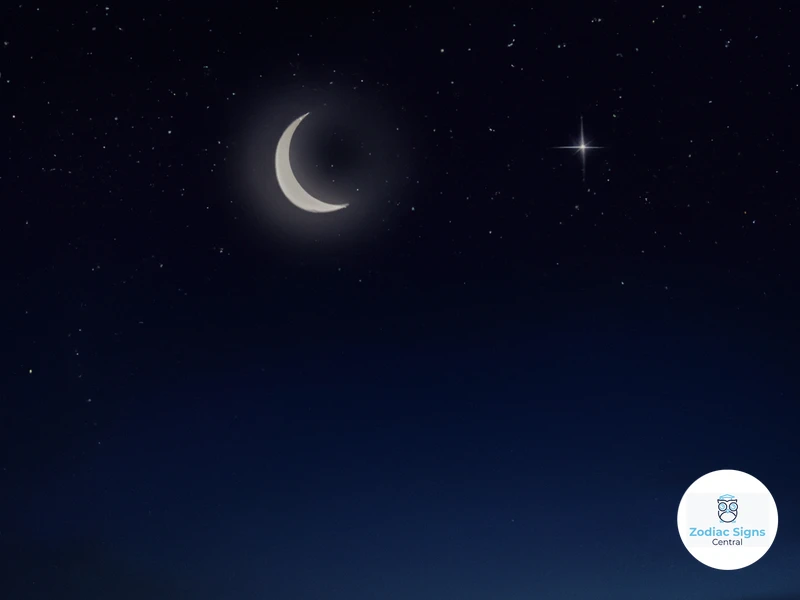
Astrology recognizes the Moon as a significant celestial body that holds deep symbolism and influence. Here, we explore three key aspects of the Moon’s symbolism in astrology.
1. Emotions and Intuition: The Moon is associated with emotions, representing the depths of our inner feelings and intuition. It governs our emotional responses, subconscious mind, and nurturing instincts. Just as the Moon’s phases change, our emotions also ebb and flow, reflecting the cyclical nature of life.
2. Reflection and Inner Self: The Moon symbolizes self-reflection and the understanding of our inner selves. It invites us to explore our hidden desires, fears, and dreams. Like the Moon’s gentle glow illuminating the darkness, it encourages us to tap into our intuitive wisdom and connect with our true essence.
3. Cycles and Rhythms: The Moon represents cycles and rhythms, mirroring the natural patterns found within the universe. It governs the monthly lunar cycle, emphasizing the importance of timing and transformation in our lives. The Moon’s gravitational pull also affects the tides, indicating the ebb and flow of energy and the need to harmonize with the natural rhythms of life.
The symbolism of the Moon in astrology offers insight into our emotional landscape, inner journey, and alignment with the flow of the universe. By understanding and embracing the Moon’s symbolism, we can navigate our lives with heightened self-awareness and a deeper connection to the cosmic energies that surround us.
1. Emotions and Intuition
Emotions and intuition play a significant role in the symbolism of the Moon in astrology. The Moon is often associated with our deepest emotions and innermost feelings. Just as the Moon influences the tides of the ocean, it also has a profound impact on our emotional well-being and moods. In astrology, the Moon represents our emotional responses, how we nurture ourselves and others, and our subconscious desires.
The Moon’s Influence on Emotions:
– The Moon’s position in our birth chart reveals our emotional nature and how we express our feelings.
– It governs our instincts and how we intuitively respond to situations.
– As the Moon waxes and wanes, it mirrors the ebb and flow of our emotional states.
– The Moon’s placement in specific zodiac signs can influence our emotional tendencies. For example, a Cancer Moon is highly sensitive and nurturing, while an Aries Moon may be more impulsive and quick to anger.
– The Moon’s aspects to other planets in the birth chart provide further insights into our emotional patterns and reactions.
The Moon’s Connection to Intuition:
– The Moon is deeply connected to our intuition and psychic abilities.
– It symbolizes our ability to tap into our subconscious mind and access hidden knowledge.
– Moon phases, such as the Full Moon or New Moon, are believed to enhance our intuitive abilities and provide clarity.
– Journaling or reflecting during the Moon’s phases can help us gain insights and access our intuition.
– The Moon’s influence on our dreams is another manifestation of its connection to our subconscious mind.
– Exploring and understanding our lunar placements in astrology can help us embrace our emotional intelligence and harness our intuitive powers.
The Moon’s symbolism in astrology is a powerful reminder of the intricate relationship between our emotions, intuition, and the cosmos. By paying attention to the Moon’s placement in our birth chart and the lunar cycles, we can gain a deeper understanding of our emotional landscape and tap into our intuitive abilities to navigate life’s challenges.
2. Reflection and Inner Self
The Moon’s symbolism in astrology goes beyond its physical presence in the night sky. One of the key aspects associated with the Moon is its representation of reflection and the inner self. Just as the Moon reflects the light of the Sun, it encourages individuals to look inward and explore their emotions, intuition, and subconscious mind.
Self-Reflection: The Moon urges us to take a closer look at ourselves and engage in introspection. Its energy encourages us to examine our thoughts, feelings, and behaviors, providing an opportunity to gain self-awareness and understand our deepest desires and needs. This process of self-reflection can lead to personal growth and transformation, allowing us to make conscious choices and align our actions with our true selves.
Intuition: The Moon is closely associated with intuition and the unconscious mind. It encourages us to trust our gut instincts and listen to that inner voice guiding us. This intuitive energy can help us navigate through life’s challenges, make decisions, and tap into hidden wisdom that lies within us.
Emotional Depth: The Moon’s energy is deeply connected to our emotions and emotional well-being. It governs our feelings, moods, and instincts, influencing how we respond to situations and interact with others. The Moon encourages us to embrace and honor our emotions, allowing us to gain a deeper understanding of ourselves and others.
Through the symbolism of reflection and inner self, the Moon serves as a reminder to turn our gaze inward, explore our emotions, and connect with our intuitive nature. By embracing this lunar energy, we can develop a deeper understanding of ourselves and lead more authentic and fulfilling lives.
3. Cycles and Rhythms
The Moon, with its ever-changing phases, represents cycles and rhythms in astrology. Each lunar cycle lasts approximately 29.5 days, as the Moon moves through its phases from new moon to full moon and back again. This cyclical nature mirrors the ebb and flow of life itself. The phases of the Moon symbolize different stages and energies that we experience throughout the month.
New Moon: The new moon marks the beginning of a new lunar cycle. It represents a time of initiation, setting intentions, and planting seeds for the future. It is a period of new beginnings and fresh starts.
Waxing Crescent: As the Moon starts to wax, it grows larger in the sky. This phase symbolizes growth, development, and the building of momentum towards manifesting our desires.
First Quarter: The first quarter moon is a time of overcoming obstacles and taking action. It is a phase of challenges, decisions, and the need to find balance between different aspects of our lives.
Waxing Gibbous: During this phase, the Moon continues to grow in illumination. It represents a time of refinement and fine-tuning our goals, as we move closer to the full moon.
Full Moon: The full moon is a time of illumination, manifestation, and heightened emotions. It symbolizes completion, fulfillment, and a culmination of energy. Many rituals and celebrations are centered around the full moon, harnessing its powerful energy.
Waning Gibbous: As the Moon starts to wane, it begins to decrease in illumination. This phase represents a time of reflection, release, and letting go of what no longer serves us.
Last Quarter: The last quarter moon is a phase of evaluation and re-evaluation. It urges us to assess our progress, make necessary adjustments, and prepare for the next cycle.
Waning Crescent: The waning crescent is the final phase before the new moon. It is a time of rest, rejuvenation, and introspection. It encourages us to recharge and gather our energies for the upcoming cycle.
These lunar phases reflect the natural rhythms of life, reminding us of the importance of embracing change, honoring our own cycles, and flowing with the ever-shifting tides. The Moon’s cycles correlate with our own experiences, influencing our emotions, energy levels, and spiritual growth. Understanding and working with the moon’s rhythms can provide a deeper connection to ourselves and the world around us.
The Moon in Horoscopes
The Moon plays a significant role in astrology and is a key component of horoscopes. The placement of the Moon in a person’s birth chart can provide valuable insights into their emotions, instincts, and inner self. 1. The Moon Sign and Personality: The position of the Moon at the time of birth determines the individual’s Moon sign, which represents their emotional nature. For example, someone with a Moon in Cancer may be nurturing and sensitive, while those with a Moon in Aries may have a fiery and impulsive nature. 2. The Moon Phases and Life Patterns: The different phases of the Moon, such as the New Moon or Full Moon, are believed to influence various aspects of life. Astrologers interpret these phases to understand the patterns and themes that can manifest in different areas, such as relationships, career, or personal growth. Understanding the lunar phases can help individuals align their actions with the energetic influences of the Moon. 3. Lunar Transits and Emotional Effects: As the Moon moves through the zodiac, it forms aspects with different planets in a person’s birth chart, creating a unique emotional climate. These lunar transits can influence moods, energy levels, and overall well-being. Astrologers analyze these transits to provide insights into emotional patterns and advise individuals on how to navigate them. The Moon’s position and interactions with other planets in a horoscope can offer valuable guidance for emotional self-awareness and growth. Whether it’s understanding one’s Moon sign, tracking the lunar phases, or reflecting on the emotional effects of lunar transits, the Moon’s presence in horoscopes invites us to explore the depths of our inner selves and harness the lunar energies to navigate life’s journey.
1. The Moon Sign and Personality
Your moon sign in astrology represents your emotional nature and inner self. It reveals the way you respond to your emotions, process feelings, and express yourself on a deeper level. Each zodiac sign has a corresponding moon sign, which can greatly influence your personality traits and emotional tendencies.
Aries Moon: If you have an Aries moon sign, you might have a fiery and passionate nature. You are likely to be spontaneous, bold, and assertive in expressing your emotions.
Taurus Moon: People with a Taurus moon sign are known for their calm and grounded nature. They value stability and comfort, seeking emotional security and enjoying simple pleasures.
Gemini Moon: Gemini moon signs indicate a curious and adaptable personality. You may have a quick-witted and communicative nature, expressing your emotions through words.
Cancer Moon: Cancer moon signs are known for their deep emotional sensitivity and intuition. You may be nurturing, protective, and strongly connected to your family and home.
Leo Moon: With a Leo moon sign, you are likely to have a dramatic and confident emotional expression. You seek attention and validation, and your creative side may shine bright.
Virgo Moon: Virgo moon signs exhibit a practical and analytical approach to emotions. You pay attention to detail, seek order, and strive for self-improvement.
Libra Moon: People with a Libra moon sign value harmony and balance in their emotional lives. You may have a diplomatic nature, seeking peace and avoiding conflict.
Scorpio Moon: Scorpio moon signs are characterized by intense emotions and depth of feeling. You possess a strong willpower and are driven by your passions.
Sagittarius Moon: If you have a Sagittarius moon sign, you may possess adventurous and optimistic emotional tendencies. You crave freedom and intellectual stimulation.
Capricorn Moon: Capricorn moon signs are known for their practical and disciplined approach to emotions. You value stability and may have a strong sense of responsibility.
Aquarius Moon: People with an Aquarius moon sign have a progressive and independent emotional nature. You may have a humanitarian outlook and value intellectual connections.
Pisces Moon: Pisces moon signs indicate a compassionate and dreamy emotional nature. You have a deep empathy for others and may possess strong intuition.
Understanding your moon sign can provide insights into your emotional needs, inner emotional landscape, and how you process and respond to the world around you. It’s important to consider your moon sign alongside your sun sign for a more comprehensive understanding of your personality and emotional workings.
2. The Moon Phases and Life Patterns
The Moon undergoes different phases as it orbits the Earth, and these phases have long been associated with various patterns and cycles in human life. Each phase represents a different energetic state that can influence our emotions, behaviors, and experiences.
New Moon: The New Moon marks the beginning of the lunar cycle when the moon is completely dark and invisible in the night sky. This phase represents new beginnings, fresh starts, and planting the seeds of intention. It is a time for setting goals, making plans, and initiating new projects.
Waxing Crescent: As the Moon begins to wax, a small sliver of light becomes visible. This phase symbolizes growth, expansion, and the building of momentum. It is a time for taking action, making progress, and nurturing our intentions to manifest our desires.
First Quarter: At this phase, half of the Moon is illuminated, resembling a half-moon shape. The First Quarter signifies challenges, decision-making, and overcoming obstacles. It is a time to reassess our progress, make adjustments if necessary, and find balance between conflicting energies.
Waxing Gibbous: The Moon continues to grow, and more than half of its surface becomes illuminated during the Waxing Gibbous phase. This phase represents refinement, fine-tuning, and preparation for the fulfillment of our goals. It is a time for gathering resources, honing skills, and tying up loose ends.
Full Moon: The Full Moon is a powerful phase when the entire face of the Moon is visible. Its radiant energy amplifies emotions, illuminates truths, and brings situations to a climax. This phase is associated with heightened intuition, releasing old patterns, and embracing transformation and fruition.
Waning Gibbous: As the Moon begins to wane, its illuminated surface decreases to slightly less than a full moon. The Waning Gibbous phase represents reflection, gratitude, and introspection. It is a time for evaluating progress, expressing gratitude, and releasing anything that no longer serves us.
Last Quarter: In the Last Quarter phase, half of the Moon is illuminated, but on the opposite side from the First Quarter. This phase brings a sense of completion, finalization, and closure. It is a time for letting go, releasing attachments, and clearing space for new opportunities.
Waning Crescent: The final phase of the lunar cycle is the Waning Crescent, where only a small sliver of the Moon is visible. This phase represents surrender, rest, and introspection. It is a time for healing, rejuvenation, and preparing for the next lunar cycle.
Throughout life, these moon phases can mirror the patterns and cycles we experience. Just as the moon waxes and wanes, our lives are filled with beginnings, growth, challenges, successes, and endings. By aligning with the energy of each moon phase, we can gain insight, make conscious choices, and flow with the natural rhythms of life. Whether we seek manifestation during the New Moon, reflection during the Waning Crescent, or transformation during the Full Moon, the moon phases offer us a guide to navigate our own life patterns and embrace the ever-changing nature of existence.
3. Lunar Transits and Emotional Effects
Lunar transits play a significant role in astrology, particularly when it comes to understanding and interpreting our emotional states. As the Moon moves through the zodiac, it forms different aspects and connections with other planets, influencing our moods, feelings, and overall emotional well-being. These transits can be a powerful indicator of the emotional energy we experience at any given time.
1. New Moon: During a New Moon, when the Moon is in conjunction with the Sun, emotions may feel introspective and in need of a fresh start. It’s a time for setting intentions, new beginnings, and planting the seeds of future goals.
2. Full Moon: The Full Moon, when the Moon is opposite the Sun, is known for heightened emotions and intensified feelings. It illuminates the subconscious mind and brings emotions to the surface, sometimes leading to restlessness and heightened sensitivity.
3. Moon Void of Course: When the Moon makes its last major aspect to a planet before changing signs, it enters a period known as the Moon Void of Course. This is a time when emotions may feel uncertain or scattered, and it’s often advised to avoid making major decisions during this period.
4. Moon-Sign Transits: When the Moon transits through a particular zodiac sign, it can bring forward the energy and qualities associated with that sign. For example, when the Moon transits through a fire sign like Aries, emotions may become more passionate and assertive, while a transit through a water sign like Cancer can heighten emotional sensitivity and nurture our need for emotional security.
Understanding lunar transits and their emotional effects can provide us with valuable insights into our inner world and help us navigate our emotions with clarity and self-awareness. It reminds us that our emotions are not static but fluctuate with the ever-moving celestial energies around us. By working with these energies, we can harness the power of the Moon to enhance our emotional well-being and personal growth.
Conclusion
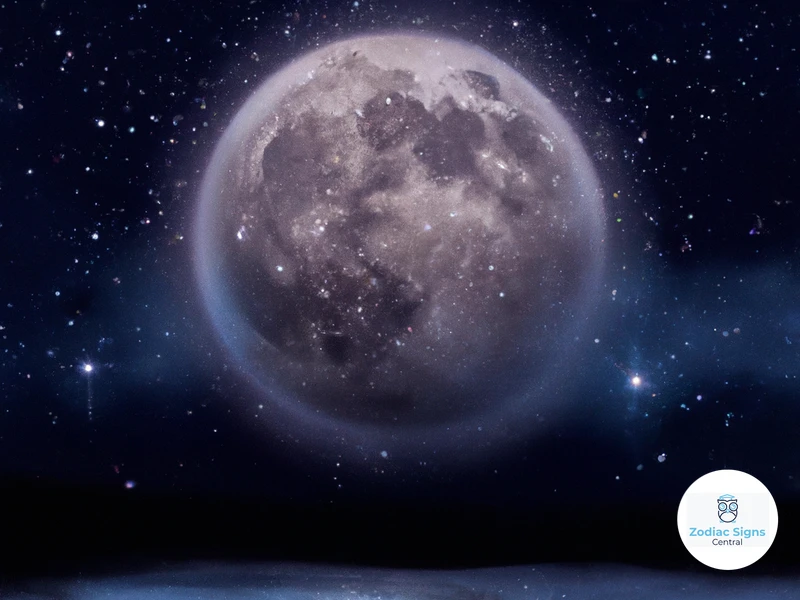
In conclusion, the mythology and symbolism surrounding the Moon offer a glimpse into the deep cultural significance it holds across various civilizations. From the Greek goddess Selene to the Roman deity Luna and the Chinese goddess Chang’e, the Moon has been revered and worshipped throughout history. Its association with emotions, intuition, and inner self in astrology adds another layer of meaning to its mystical allure. The Moon’s phases and transits are believed to play a significant role in shaping our personalities and emotional well-being. Understanding the symbolism and mythology behind the Moon allows us to appreciate its profound influence on our lives and the world around us. Whether you are fascinated by the lunar deities, intrigued by ancient moon worship, or seek guidance from astrology, the Moon continues to inspire and intrigue us with its enigmatic power. So next time you gaze up at the night sky and see the radiant orb, remember the rich history and symbolism that the Moon represents. It has the power to connect us to our emotions, our intuition, and the cycles and rhythms of the universe.
For more insights into celestial events and their impact, be sure to check out our article on the power of solar eclipses or how retrograde planets affect zodiac signs. You can also explore your yearly financial outlooks in our yearly horoscope.
Frequently Asked Questions
1. How did the mythologies surrounding the Moon develop?
The mythologies surrounding the Moon developed as a way for ancient civilizations to explain the celestial phenomenon and give meaning to its presence in the night sky. These myths often incorporated elements of nature, human emotions, and divine beings to create captivating stories and symbolize various aspects of life.
2. What role did the Moon play in ancient Mesopotamian worship?
In ancient Mesopotamia, the Moon held great significance in religious rituals and worship. It was associated with the god Sin, who symbolized the moon’s power and deity. The Mesopotamians believed that the phases of the Moon directly influenced the rhythms of life and played a crucial role in determining the appropriate time for important activities such as planting, harvesting, and religious ceremonies.
3. How did the moon and serpent symbolism intertwine in Mesoamerican cultures?
Mesoamerican cultures, such as the Aztecs and Mayans, often associated the moon with serpents. The serpent was seen as a powerful symbol of transformation and rebirth, closely linked to the moon’s cycles. The moon and serpent symbolism represented the cyclical nature of life, death, and regeneration in these ancient civilizations.
4. What are the moon’s mythological associations in Hinduism?
In Hinduism, the moon holds a significant place in mythology and symbolism. It is associated with the deity Chandra, who is considered the god of the Moon. The moon’s waxing and waning phases are believed to mirror the cycle of creation and destruction, reflecting the eternal rhythm of life and the divine forces at play.
5. How is the Moon symbolized in astrology?
In astrology, the Moon symbolizes emotions, intuition, and the subconscious mind. It represents our inner self, our deepest desires, and the nurturing aspect of our personality. The Moon’s placement in our birth chart is believed to influence our emotional nature and how we express our feelings.
6. What is the significance of the Moon sign in astrology?
In astrology, the Moon sign represents our emotional nature and inner needs. It reflects how we instinctively react to situations and the type of emotional security we seek. Understanding our Moon sign can provide valuable insights into our emotional well-being and help us navigate our relationships and reactions to life’s challenges.
7. How do lunar phases impact our lives?
Lunar phases have long been believed to influence various aspects of our lives. The waxing and waning of the Moon can be associated with growth, manifestation, release, and introspection. Many people believe that aligning their actions and intentions with the different lunar phases can enhance the effectiveness of their endeavors.
8. Can the Moon’s transits affect our emotions?
Yes, the Moon’s transits can have an impact on our emotions. As the Moon moves through the zodiac, it forms aspects to other planets in our birth chart, influencing our mood, reactions, and general emotional state. It is not uncommon to experience shifts in energy and heightened sensitivity during certain lunar transits.
9. How does the Moon’s placement in a birth chart affect our personality?
The Moon’s placement in a birth chart can provide insights into our emotional needs and how we express our feelings. It influences our instinctual responses, nurturing tendencies, and overall emotional well-being. The Moon’s sign, house, and aspects in our birth chart all contribute to shaping our personality and emotional landscape.
10. What is the significance of a solar eclipse in astrology?
Solar eclipses hold astrological significance as they are associated with major shifts and breakthroughs. They often mark transformative periods and can bring about significant life changes. Astrologers believe that solar eclipses have the potential to awaken dormant energies, stir personal growth, and catalyze important shifts in various areas of our lives.
References
Frequently Asked Questions
1. Why is the moon associated with femininity and goddesses?
The association of the moon with femininity and goddesses is rooted in many ancient cultures where the moon was seen as a symbol of fertility, nurturing, and intuitive powers – traits often associated with femininity.
2. What are some common moon symbols in different cultures?
Some common moon symbols in different cultures include the crescent moon, which represents growth and change, and the full moon, which symbolizes completeness and enlightenment.
3. How did the moon influence ancient religious practices?
The moon had a significant influence on ancient religious practices as it was often worshipped as a deity or associated with various gods and goddesses. Its cycles and phases were believed to hold mystical and spiritual significance.
4. What is the significance of the moon in astrology?
In astrology, the moon represents emotions, intuition, and the subconscious mind. It is believed to influence our moods, behavior, and innermost desires.
5. How does the moon sign affect one’s personality?
The moon sign in astrology reflects an individual’s emotional nature and inner self. It provides insights into their instinctual reactions, nurturing tendencies, and their emotional needs.
6. What are the different moon phases and their meanings?
The different moon phases include the new moon, which signifies new beginnings; the waxing crescent, representing growth and intentions; the full moon, symbolizing abundance and completion; and the waning crescent, associated with release and letting go.
7. How do lunar transits affect our emotions?
Lunar transits, which occur when the moon moves through different zodiac signs, can influence our emotional state and mood. Each sign brings its own energy and emotional undertones, which can affect our feelings and reactions.
8. What role did the moon play in ancient Mesopotamian culture?
In ancient Mesopotamia, the moon was worshipped as a powerful deity known as Nanna or Sin. It was believed to guide human destiny, control the tides, and influence fertility and agricultural cycles.
9. How is the moon connected to Hindu mythology?
In Hindu mythology, the moon is associated with the deity Chandra, symbolizing emotional and intellectual brilliance. The moon is also related to the story of Lord Rama’s wife, Sita, who was held captive on the moon by the moon god.
10. What is the significance of the moon and serpent in Mesoamerican cultures?
In Mesoamerican cultures like the Aztec and Maya, the moon is often depicted with serpents and is associated with regeneration, cycles of life and death, and the balance between light and darkness.
